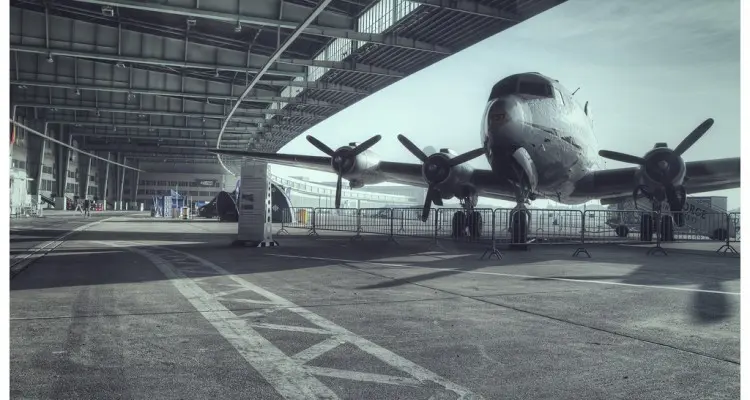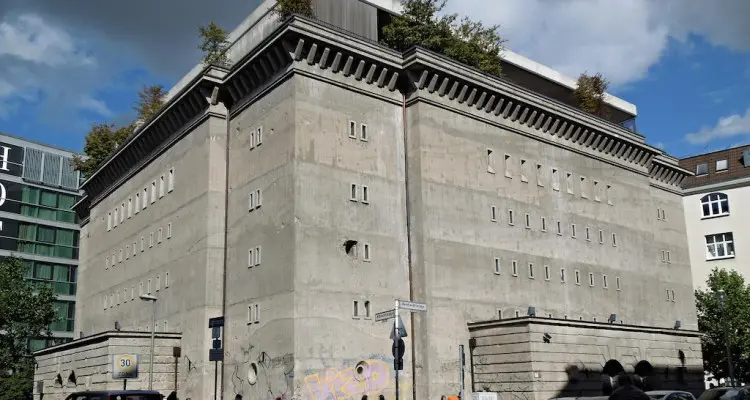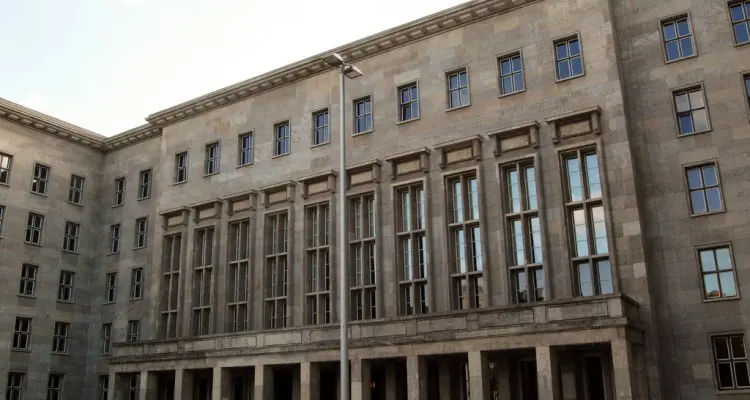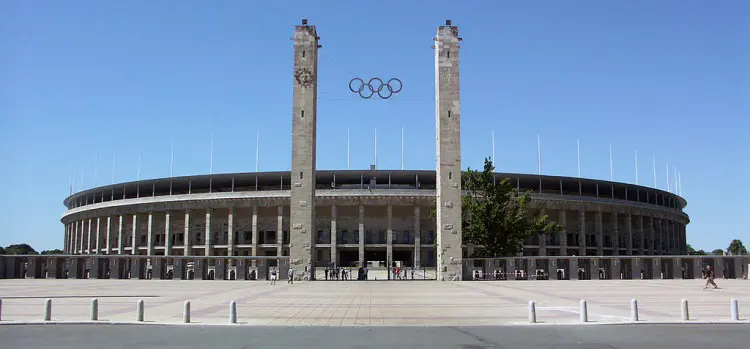Editor’s note: Architecture student Tadeas shares with us his pick of 5 still-standing examples of Nazi architecture in Berlin. At the end of the post you’ll find a map with the locations marked, for you to explore on your own.
Few cities in the world are as charged with historic meaning as Berlin. The violent forces of the 20th century did more to take away from the city, but they also contributed to the evolving structure of this metropolis. Beginning in 1933, Adolf Hitler and Albert Speer dreamt of a metropolis worthy of the new German empire. Their plan was so grand and ambitious that only the subsequent Allied bombing could match its scale through violence. Only a few buildings from this gargantuan scheme were actually constructed. In this article I selected those that are interesting not only because of their terrifying historic status, but, more importantly, for their architectural value. The totalitarian system in general seems to show a certain leaning towards empty historical yet classicist styles. However, the buildings I have selected are more than just a failed episode in the history of architecture. There is even a certain resemblance one can see with some of the most contemporary buildings in central Europe.
Jump to a section of this article
1 Tempelhof Airport
1935-1939
Platz der Luftbrücke, U-Bahn Platz der Luftbrücke
This is a typical example of a building whose historic significance positively clouds its architectural value. The Tempelhof Airport was the site of the so-called ‘Berlin Airlift’. During the Soviet blockade between June 1948 and September 1949 it remained the sole means to supply the 2.25 million West Berliners with their basic needs.
The airport was built between 1936 and 1941 and immediately upon completion claimed to be the world’s biggest building. The layout is a 1.2 kilometre circular quadrant connected to a lobby space in the centre. This huge mass is unified with a shell limestone covering. Its most interesting feature is the 18 meter canopy roof that hovered above the docked airplanes without any visible means of support. This immense curved beam creates an extremely monumental spatial effect.
2 Air Raid Bunker
1942 by Karl Bonatz
Albrechtstrasse 24-25, U-Bahn Friedrichstrasse
The anti-aircraft bunker, or Luftschutzbunker, is a German invention that followed the first Allied air-raids in Berlin in 1940. Like the Allied bombing of Berlin, they didn’t have much tactical meaning. These above ground towers were meant more as a symbol of fortification than an actual instrument of effective protection. As such, these towers received special treatment compared to any other utilitarian military structures: they were designed by architects. In the case of this one, Karl Bonatz took inspiration from renaissance palaces. The anti-aircraft bunkers became one of the last concentrations of Nazi resistance during the battle for Berlin. Many attempts were made to destroy them both during and after the conflict. One of the last remaining fragments is the Bunker on Albrechtsrasse, which has recently been transformed into an art gallery.
3 Reich Aviation Ministry
1935-1936
Leipziger Strasse 5/7, Wilhelmstrasse 97, U-Bahn Potsdammer Platz
Although it is equally, if not more historically important compared to others in this collection, the Aviation Ministry seems to lack a truly symbolic charge. It was built as a modern utilitarian office block for Göring’s brand new Aviation Ministry in 1935. As many of the office blocks of our time, it is quite generic in many senses. Yet it was meant as a gesture, a symbol of defiance against the Versailles Treaty in forbidding Germany to have an Air Force. Its physical presence in the city is immense: over 2000 offices with a floor area of over 110,000 square meters. The steel prefabricated structure is covered and ‘monumentalized’ with limestone blocks, subtle ornaments and a massive cornice. The entry was designed as a passage through a ‘court of honour’ followed by a sequence of rooms leading to a lavish ‘banquet hall’. It was in this very hall where the official ceremony to establish the GDR (East Germany) took place. This threatening monster is the seat of the Ministry of Finance today. And Germany prospers.
4 Reich Sports Fields
1925-1936
Olympischer Platz. U-Bahn Olympia Stadion
In 1936 Hitler got an unparalleled global propaganda opportunity: the Olympic Games. It was supposed to show German triumph in organisation, choreography and sport but also architecture and art. An immense complex was built: a stadium, different types of sport fields (that were actually marching fields), a pool, bell tower, etc. From an architectural point of view, the stadium is the most interesting. Its sporting ground is significantly lower than ground level which creates an interesting theatrical effect. An ordinary visitor arrives through a ground floor gate and without climbing a single step immediately finds himself high up in the auditorium, looking down on the pitch. From outside, this trick disguises the real scale of the building, allowing for an elegant and almost gentle colonnade appearance. This concealing trick very much resonates with the way in which the athletic event was misappropriated on behalf of totalitarian propaganda.
5 Propaganda Ministry
1934-1938
Wilhelmstrasse 49, Mauerstrasse 45-52
U-Bahn Mohrenstrasse
Goebbels’ Reichs Ministry of Enlightenment and Propaganda in many ways mirrors the story of Goring’s Ministry of Aviation – a very centralized office in search of a monumental expression of its acclaimed new power. The difference is that instead of a green plot, Goebbels received a stately palace designed by the most skilled classicist architect of the 19th century – Friedrich Schinkel. Several additions were made to this palace, some of them shadowing it in scale, none though in quality. The craftsmanship in which the stone facades are created, the overwhelming rhythm of the windows, the subtle and mystifying cornices create a somewhat interesting whole. Architect Karl Reiche first carried out a smaller extension somewhat bluntly decorated with pilasters and arches. In the second extension he gave up all such expressive elements, except those of detail, like window framing, entrances, etc. Schinkel’s classicist palace had been destroyed during the war, but all the additions are still standing. The former Propaganda Ministry is now ironically the seat of the Ministry of Social Affairs and is open to visitors as long as they book a tour in advance.
Planning a trip to Berlin? We’d love to put together a Berlin travel package just for you. Get in touch to find out more!
List of illustrations:
Tempelhof Airport – Alexander Rentsch via Creative Commons on Flickr
Air Raid Bunker – Tobias Nordhausen via Creative Commons on Flickr
Reich Aviation Ministry – Blaine O’Neill via Creative Commons on Flickr (link no longer valid)
Reich Sports Fields – Markus Kolletzky via Creative Commons on Flickr
Propaganda Ministry – Gawker Media
Platz der Luftbrücke, Berlin
Albrechtstrasse 24-25, 12167 Berlin, Germany
Leipziger Strasse 5/7, 10117 Berlin, Germany
Olympischer Platz, Berlin, Germany
Mauerstraße 45-52, 10117 Berlin, Germany

As far as I remember, I have always wanted to be an architect. No wonder, I have spent most of my life in a living architectural textbook – Prague. I undertook internships in various architectural practices in Czech Republic, UK and Holland, including MVRDV Rotterdam. Now I live in the Netherlands where I study at one of the world’s leading architectural universities, TU Delft. I miss Prague.





This is amazing. I only saw hints of Nazi architecture from movies and thought they quite hold up this haunting sleeping beast that once stood alongside the ambitious reign of Hitler, they were interesting really. Deadly, heavy, historical.
It might be a shame that I had only done some research on it now. That air bunker is definitely going to my list of case studies.